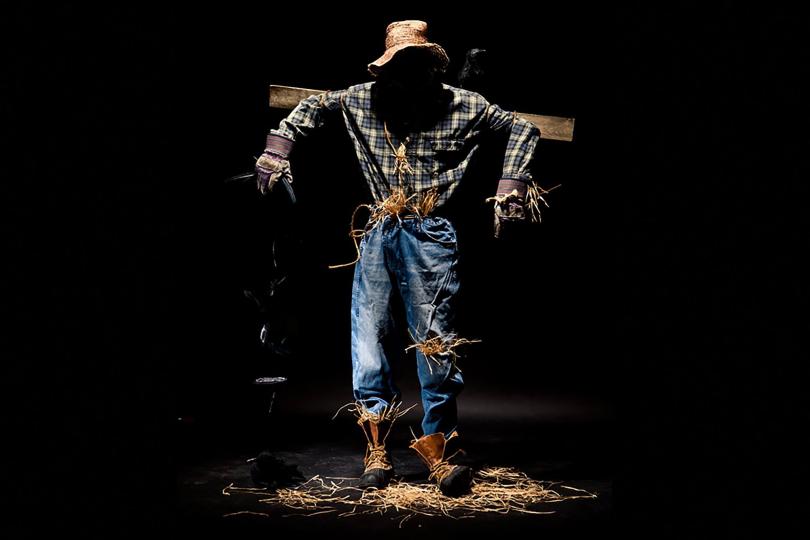Twin Cities Horror Festival digs for the fear inside us all

In my previous Twin Cities Horror Festival review, I noted that all of the opening night plays shared a common theme of the duality of personal identity. Having now seen two-thirds of this year’s TCHF offerings, I can report that we’re eight-for-eight. I suppose it’s not surprising that identity figures extensively in the horror landscape of 2017. It’s been a year of introspection for plenty of artists, all of them working against the backdrop of a house divided against itself. Those intensely personal divisions come through loud and clear in the latest edition of TCHF, and they manifest themselves in as many ways as there are plays.
Maniacal maneuvers in the dark
For their sixth TCHF appearance, Four Humors has revived its original offering, 2012’s Harold. The story follows goat-rancher brothers Matt Spring and Brant Miller going slowly stir crazy while spending a summer in a remote cabin with only each other, a stack of poetry books, a Merle Haggard 45, and a handmade scarecrow for company. As the isolation wears away at them, the scarecrow becomes a convenient receptacle for all of their unwieldy emotions and unsavory urges, leading to a not-unexpected but still unsettling turning of the tables.
Harold is a bit of an oddity for a TCHF show, presented as it is in the round, with several rows of seats ringing the action directly on the Southern Theater stage. It’s an appropriate choice for a show that leans heavily on the tradition of telling scary stories around a campfire, an approach enhanced all the more by Jon Kirchofer’s lighting design. Harold opens with a pitch-black room and frequently plunges back into darkness throughout its run, leaving the audience to interpret the shufflings and yelps onstage for themselves. When the lights - a single flickering bulb and a handheld flashlight - do come on, it’s sometimes in service of a jump scare or a shocking reveal, but just as often it adds another layer to the tense banality of life in the cramped cabin, a situation that feels bound to boil over before very long.
Like most Four Humors productions, Harold brings runs deeper than it might appear at first glance, lacing its scary scarecrow story with quiet observations about cycles of abuse and toxic masculinity. All told, it’s a spooky slow-burn that keeps its audience on edge and makes great use of its environment.
Casting long shadows
Speaking of that environment, let’s take a minute to appreciate the Southern Theater. It’s one of my favorite venues in town no matter what’s on stage, but it’s hard to imagine the Horror Festival working nearly as well in any other venue. The decaying archway, the scarred walls, the black expanse of the stage - these are ideal environs for horror theater, and a number of the most successful shows lean into that.
Brooklyn-based duo The Coldharts have mounted four TCHF productions and clearly know their way around the Southern stage. The most striking sequences of their semi-musical, semi-biography Eddie Poe incorporate the venue expertly, with Nick Ryan and Katie Hartman casting long shadows across the back wall during particularly dramatic moments. The effect is something like watching sinister shadow puppetry superimposed against a more traditional stage production, and it’s hugely effective.
The show as a whole is something of an origin story for Edgar Allan Poe, delving into his teenage school days as an alcoholic gambler who can’t figure out why his academic prowess isn’t translating to popularity. Ryan plays Poe as a petulant oddball constantly struggling to keep his flair for self-destruction at bay as he’s dogged by unrequited lovers, better-heeled schoolmates, a doubting brother, and a mocking mirror image of himself (all played ably by Hartman).
The duo acknowledges at the end of the show that Eddie Poe is a work in progress, and that sometimes shows. It’s less lively than some previous Coldharts productions, and the song score is fun but not especially memorable. Still, moments like that spectacular shadow sequence and the generally irresistible stage presence of Katie Hartman make this recommendable, although you’d be forgiven if you’d rather wait to see it with another coat of polish.
Revisiting a familiar Family
Elsewhere on the horror biography front, TCHF newcomers Boston Community Collaborative make good on their out-of-town engagement with Sadie Mae, 1969, a loose look at the most important months in the life of Charles Manson acolyte Susan Atkins, aka Sadie Mae Glutz. The Manson clan is well-trod territory in pop culture circles, and while BCC’s take doesn’t break any new ground, it offers a confident, unsettling spin on one of the last century’s most-told horror stories.
Anchored by Erica Wisor’s magnetic title performance, Sadie Mae doesn’t try to humanize Atkins or even to figure out what makes her tick so much as it presents snapshots from the disturbing life of a disturbed human. The show around her is low-key but dynamic, full of bustling interchanges of bodies and dance routines set to well-worn Beatles tunes that take on a menacing air in this context. Whether fraternizing with the cellmates who will later testify against her, soaking up manifestos from the messiah who will drag her down with him, or listening to the pleas of the victim who will forever haunt her, Wisor’s Sadie Mae is a mesmerizing enigma, and Sadie Mae is a worthy entry in the sprawling canon of Mansonia.
Spilling blood with a purpose
Dangerous Productions has built a reputation over its TCHF run as the bloodiest show in town, to the point where the company seems to be scaling back the gore slightly so as not to let the special effects drive the story rather than vice versa. It’s a wise choice for a group whose past productions have involved bags of meat tumbling from the rafters and performers emerging from human-sized vats of stage blood.
That isn’t to say that this year’s Skin is lacking in gore - you’ll get all the gushing jugulars, severed noses, and flayed bellies you’re looking for - but it’s all in service of the company’s most overt social commentary to date. This take on the mad scientist genre tosses us into a home surgery operation where cheerful doctor Garrett Vollmer offers pro bono work to black women with body image issues. As you might have guessed, the surgeon’s intentions aren’t entirely honorable.
Oya Mae Duchess-Davis’s script isn’t shy about its cultural appropriation metaphor, as a trio of ghoulish white women eagerly covet the physical attributes that the black women have been made to feel ashamed of. The grim subject matter is handled with a bleakly comic touch that leavens the physical and spiritual mutilations unfolding onstage. Not all of it works - the story occasionally verges on the heavy-handed, and the gallows humor doesn’t always land - but it’s impressive to see Dangerous Productions’ flair for gore put to this kind of larger purpose. This time the blood spilled onstage represents only a fraction of its real-world counterpart.




